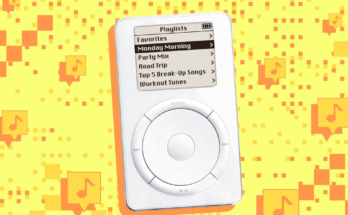Despite this being a smaller CES in some ways, we had no shortage of contenders for the awards, and we’re especially pleased to see both large and small brands represented, not to mention a mix of futuristic concepts and practical devices that are slated to go on sale this year.
Congrats to all the winners and finalists, and here’s hoping we can safely convene at this time next year. There’s nothing that can quite replace wandering the halls of a convention center, gawking and occasionally reaching out to touch. We promise we won’t take the hand sanitizer for granted. — Dana Wollman, Editor-in-Chief
Best Accessibility Tech
GoodMaps Explore (Presented by American Printing House for the Blind)

American Printing House for the Blind / Engadget
GoodMaps Explore is already a helpful navigation app for people who are visually impaired or blind, and it’s only bound to get better with time. GoodMaps Explore currently functions as an outdoor orientation device, reading aloud cardinal directions, points of interest and streets in real-time depending on where the user is pointing their mobile device. This information is displayed in reactive, easy-to-read text on the phone screen as well, helping users find new modes of independence.
Here’s where it gets experimental. Developers at the American Printing House and GoodMaps are working on adding detailed indoor navigation to the app as well, offering step-by-step directions in spaces like libraries, museums and government offices. They’re using LiDAR and image recognition software to map buildings, and already they’ve added the Cabell-Wayne Association for the Blind, Cabell County Public Library, Phil Cline Center of the Huntington YMCA, and Brad D. Smith Business Incubator in Huntington, West Virginia.
Camera-based positioning tracks the user in indoor mode, and developers say it’s accurate within three feet of any target, a major improvement over beacon technology, which has a misstep range of 10 to 15 feet. APH and GoodMaps started mapping indoor spaces in September 2020, and they promise more are coming in 2021. — Jessica Conditt, Senior Editor
Best Digital Health and Fitness Product
Omron VitalSight
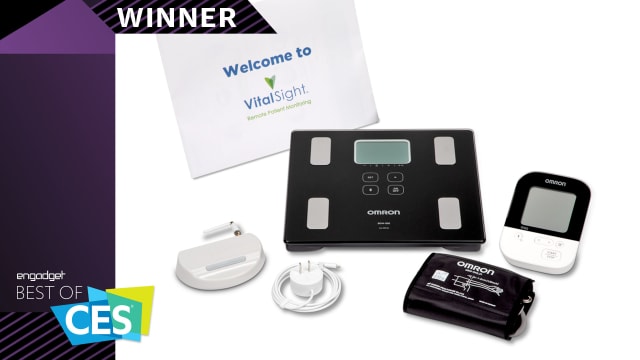
Omron / Engadget
Some Best of CES winners are simply the right device for the right moment in time. Omron’s VitalSight is a service for doctors to remotely monitor their patients’ hypertension, even while those patients stay home. That’s especially beneficial while a pandemic is raging, as people with high blood pressure may be less likely to go for routine clinical check-ups while infection risk is high.
The rise of telehealth in the COVID age has led to the adoption of various at-home smart medical devices to supplement a physician’s video call. But we were particularly impressed by VitalSight’s ease of use. The kit includes a smart cuff which can connect securely and independently to a patient’s doctor — without the need for a WiFi connection. The blood pressure data feeds straight into the patient’s electronic medical records. Healthcare professionals can then spot trends in the data, potentially intervening before a stroke or heart attack.
As experts in connected blood pressure monitors, and with existing collaborations with top US hospitals, Omron is well-positioned to make an impact at a time when everyone’s physical health feels especially vulnerable. — Chris Ip, Features Editor
Best Wearable
Wearable Devices Ltd. Mudra Band
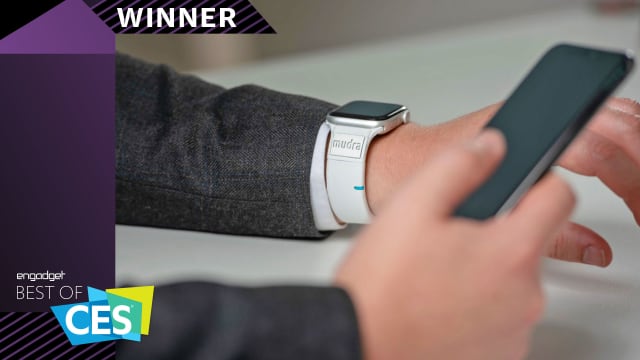
Wearable Devices Ltd. / Engadget
The Mudra Band by Wearable Devices Ltd. impressed us by making the Apple Watch even smarter with gesture control. It attaches to the Watch like any other strap, but it has extra sensors inside that let you control the smartwatch with one hand, without using the touchscreen. When paired over Bluetooth LE to the Watch, the band’s sensors detect and interpret the electrical signals that your brain sends to your fingers. Then they map those to the motions used to interact with the Apple Watch’s display, letting you do things like type out texts and open apps with a few finger movements and wrist gestures.
Unlike other companies, Wearable Devices isn’t trying to reinvent the wheel with yet another smartwatch. Rather, it’s building upon one of the most ubiquitous devices on the market and giving it practical functionality it didn’t have before. The Mudra Band also has the potential to make the Apple Watch even more accessible for people with disabilities.
So far, the underlying technology has been used in a proof of concept that allowed ALS patients to type using a virtual keyboard. But all told, the Mudra Band is hardly a hypothetical achievement: The company is already taking orders and plans to release the device in March. — Valentina Palladino, Commerce Editor
Best Transportation Technology
Mercedes-Benz Hyperscreen
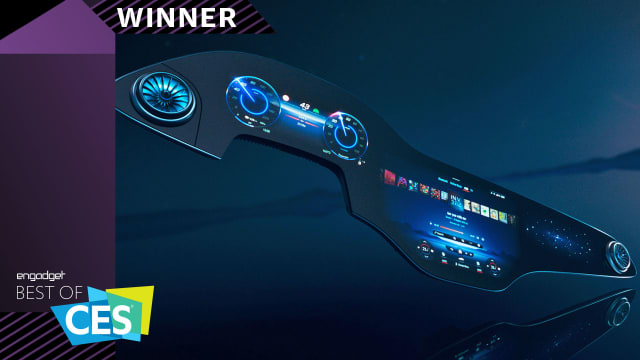
Mercedes-Benz / Engadget
When Mercedes’ newest EV, the EQS luxury sedan, hits dealer showrooms later this year some folks will be taken by its luxurious stylings; others by its entirely electric propulsion system. But most folks won’t be able to help but gawk at the massive, cabin-spanning central display the company has dubbed the Hyperscreen.
At 56 inches, the Hyperscreen spans from driver to passenger side doors, effectively replacing the entire cabin control system including the driver’s instrument cluster as well as the central infotainment and navigation panel. It even includes a secondary side screen area providing a viewing panel to passengers in the front seat. Powered by an integrated eight-core CPU with 24GB of RAM, the hyperscreen shouldn’t have much difficulty displaying most anything you can throw at it. And unlike other all-in-one EV displays, the Hyperscreen is specifically designed to be as easily accessible as possible with its most important functions set to the home screen rather than buried in the menu structure. — Andrew Tarantola, Senior Editor
Best Home Theater Product
Sony 360 Reality Audio speakers
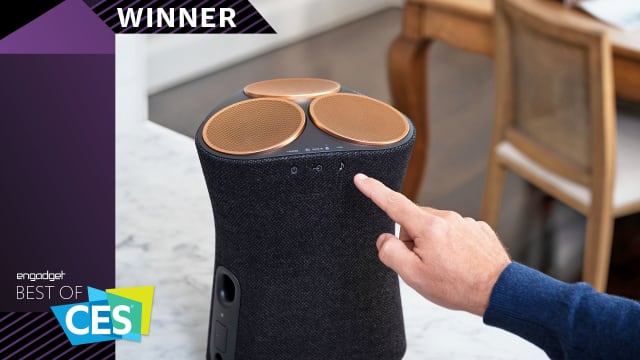
Sony / Engadget
After two years, Sony has a clear plan for bringing its 360 Reality Audio platform to the masses. A key piece of that newly announced strategy are the SRS-RA5000 and SRS-RA3000, the first two speakers supporting this immersive audio format. These devices are WiFi-connected wireless units that work in a similar fashion to Sonos. You connect them to your home network to control them with your phone. Plus, you can use them as part of a multi-room setup. What’s more, you can connect them to select Bravia TVs during your streaming binges. And when it comes to music and podcasts, Bluetooth, Spotify Connect and Google Cast are all available here.
While the 360 library is still somewhat limited, Sony is working to expand the lineup with more studio albums (new and existing) as well as live performances. If the tunes you’re listening to aren’t in the format, the speakers are equipped with an algorithm that converts the content. The company has shown off prototypes of both units at previous CES shows, and if the final product is anything like those, Sony will be poised to compete with the best brands in the connected home audio space. — Billy Steele, Senior News Editor
Best Connected Home Product
Samsung JetBot 90 AI+
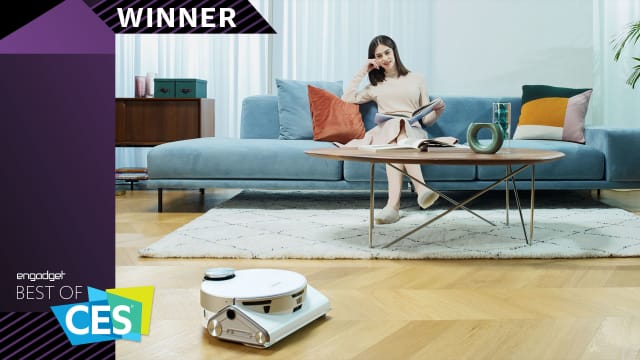
Samsung / Engadget
Robot vacuum cleaners have been cruising around floors and cleaning up after us for years, but the sensors and smarts used in Samsung’s JetBot 90 AI+ make it something special. When it wants to discern the optimal path around your home, it uses a LiDAR array that scans its surroundings and tucks away when the JetBot needs more headroom. When it comes across stuff on the ground, the JetBot uses its 3D sensors and AI image recognition to decide how best to tackle it all. (Or, in the case of dog poo, how best to avoid it.) And when the JetBot detects something you might want to see, like a pet in motion or a person walking around, it’ll push a notification and a video clip to your phone.
To many people, subjects like LiDAR and machine learning inspire blank looks; they can’t quite imagine what possible help those things could be in their day-to-day lives. The JetBot 90 AI+ is a great example of their practical value. And really, there’s nothing quite like seeing once-arcane technologies being used to tidy up around the house. — Chris Velazco, Senior Mobile Editor
Best Phone or Mobile Device
LG Rollable smartphone

LG / Engadget
Slowly but surely, smartphones are becoming more than just the glass and metal slabs we’ve grown accustomed to. We’ve already seen a smattering of high-profile foldables and dual-screen devices, but 2021 could be the year rollable phones come into their own. Case in point: the aptly named LG Rollable.
To be clear, LG isn’t alone in working on a smartphone with a seemingly normal screen that unrolls and becomes a small tablet. TCL has teased a few already, as has Oppo. That said, a few factors help set the LG Rollable apart from the rest. For one, we know it will actually be released this year — most other companies working on similar concepts haven’t made their plans clear yet. Perhaps more importantly, we’ve already seen LG build and deliver commercially viable rollable screens in the form of its Signature OLED R TV. That experience with complex components and systems, along with LG’s desire to push the smartphone design envelope, all but ensure the Rollable will be one of the most notable phones of the year. — C.V.
Best TV Product
LG C1 OLED TVs
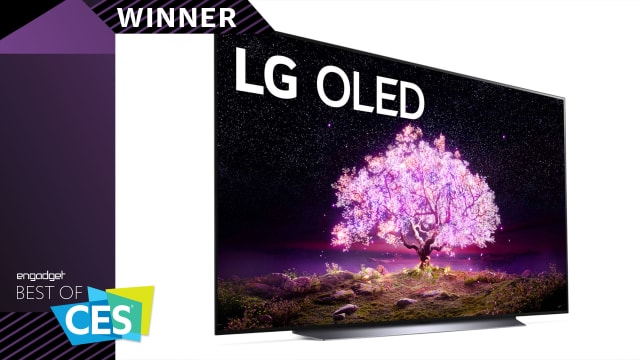
LG / Engadget
For the past several years, LG’s OLEDs have been the cream of the crop for anyone who demands the best TV quality. Unlike LCD TVs, OLEDs don’t require a backlight. Instead, each individual pixel can turn itself on and off, allowing them to display pure black levels in ways that LCDs still can’t match. Sure, we’re seeing higher-quality MiniLED LCD sets coming (LG has those two in its QNED line), but even they’re still trying desperately to catch up with the picture purity of OLED.
This year, LG has upgraded its new C1 lineup with a new image processor, the Alpha 9 Gen 4, which can “analyze and optimize” content on a scene-by-scene basis. Cinephiles will likely just want to turn off any of those features, but even if you do, you’ll still be looking at the rich colors and sparkling contrast of an OLED screen. LG says the C1’s panel hasn’t changed much from last year’s CX, but given just how good those sets were, we’re not too disappointed. The C1 line is also fully HDMI 2.1 equipped, and it can virtualize 5.1.2 surround sound with its built-in speakers. — Devindra Hardawar, Senior Editor
Best Gaming Product
AMD Ryzen 5000 mobile CPUs
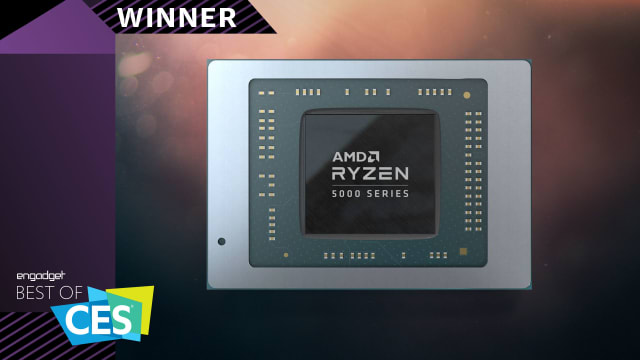
AMD / Engadget
For years, Intel has essentially been the beginning and end of the Windows laptop chip conversation, with a huge lead in market share. AMD has been trying to change that. With its Ryzen 4000 series, which debuted at CES 2020, the company made inroads, finding its way into over 100 mobile systems. At CES 2021, it’s back with an updated line of Ryzen 5000 chips, which it says will be available in over 150 systems this year.
The Ryzen 5000 series mobile chips are based on the same Zen 3 core as its class-leading 5000 series desktop chips, which offers large performance-per-watt improvements over Ryzen 4000’s Zen 2 cores. Topping out at the eight-core, 16-thread Ryzen 9 5980HX, the new processors are able to hit max boost speeds of up to 4.8GHz on a single core. There’s also a new line of more economical “U” processors, which are more powerful than last year’s 4000U series but won’t burn through your laptop’s battery: AMD claims laptops fitted with its high-end ultra-portable chip, the 5800U, will last “up to 17.5 hours” in general usage.
AMD still has a long way to go if it wants to corner the Windows laptop market, but its 5000 series is a meaningful leap forward, and will only increase competition and innovation in the space. — Aaron Souppouris, Executive Editor
Most Unexpected Product
Kohler Stillness Bath
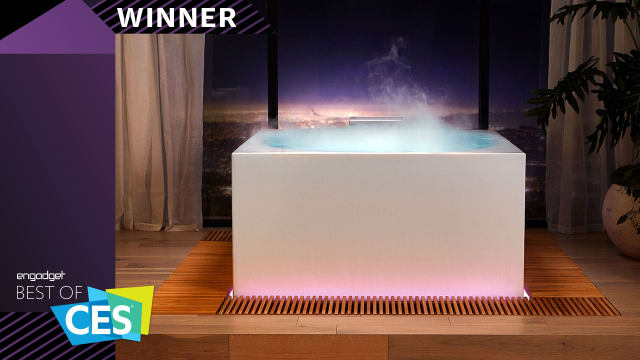
Kohler / Engadget
Tech events are typically full of bling and bluster, so it was refreshing, and rather surprising, to see a bathtub with a mood button at CES 2021. Inspired by Japanese forest bathing, the Kohler Stillness Bath actually fills from the bottom, spilling out into a wooden moat, heightening the serene experience.
There’s otherwise plenty of tech here despite its nature-inspired roots. It has a “full spectrum” mood lighting system that will bathe the tub in cool blues or warm pinks, a full-on fog generator, and you can have it emit a soothing scent for a stint of aromatherapy. In a year where going to a spa is out of the question, the Stillness Bath sure sounds like a winner to us. — Nicole Lee, Senior Editor
Best Sports Tech
Samsung Smart Trainer
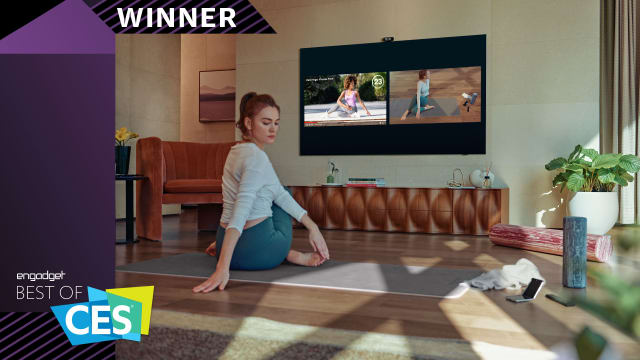
Samsung / Engadget
The idea of fitness gear that can analyze your form while you’re at home isn’t novel, but Samsung’s Smart Trainer system stands out for its ease of use. All you have to do is connect a camera to one of the company’s new QLED or 8K TVs and you’ll find dozens of compatible workout videos via the Samsung Health app. Plus, the company has wide reach and tight integration with its phones, tablets and laptops, meaning its tool could find a broad audience.
The software is still in its early stages, and it’s still imperfect. We’d also like it to eventually support more types of workouts. But as we look toward a future where exercising at home will likely be part of our new normal, a simple way to keep users accountable by measuring their reps and form feels timely and compelling. — Cherlynn Low, Reviews Editor
Best PC or Tablet
ASUS ZenBook Duo

ASUS / Engadget
ASUS’s new ZenBook Duo is the best dual-screen PC we’ve seen yet. ASUS has spent the last few years exploring how it could bring extra displays into laptops, first with the ScreenPad underneath ZenBook TouchPads, and then with the ScreenPad Plus, a wide display that sits directly underneath the main display. The new ZenBook Duo demonstrates just how much ASUS has learned over the years, with a brighter ScreenPad Plus that tilts up to be more ergonomic. And it also has updated software to make multitasking between the two displays even simpler.
In addition, the ZenBook Duo features Intel’s new 11th-gen Tiger Lake CPUs, Xe graphics and it can be configured with NVIDIA MX 450 graphics. Its sleek design also helps it stand apart from a slew of ultraportables, even though it’s slightly heavier than the competition. For the productivity hounds out there, it’s the best way to get some extra screen real estate in a thin and relatively light PC. — D.H.
Best Robot or Drone
Sony Airpeak drone
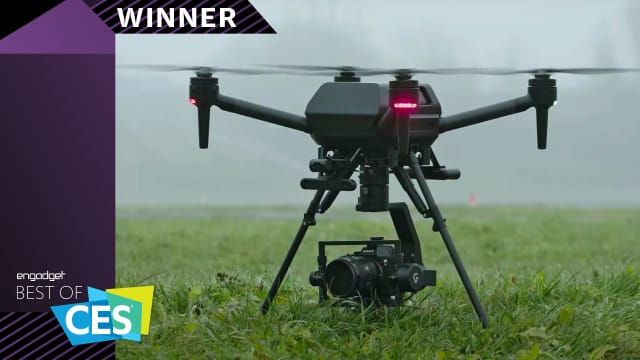
Sony / Engadget
Drones have meaningfully changed the film industry, allowing productions to shoot aerial photography easily and at much lower cost, in turn expanding the number of shots that are even technically possible. This CES, Sony — just about the biggest name in consumer technology and cameras — officially got in on the drone game.
The newly unveiled Airpeak system is a business-focused aerial platform, launching this spring. Details are sparse, but it’s exciting to see a household name enter the space, especially one with deep ties to the film industry. The quadcopter is strong enough to carry one of the company’s Alpha mirrorless cameras yet Sony claims it’s the smallest craft to be able to do so. Sony even claims Airpeak uses AI for improved stabilization. The fact that the legs fold away on take off, similar to DJI’s Inspire line, just makes it that much cooler. — James Trew, Managing Editor
Best Sustainability Product
Samsung Solar Cell Remote
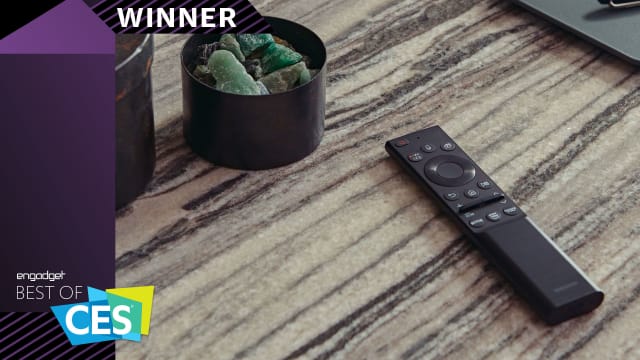
Samsung / Engadget
The vast majority of TV remotes have a slide-out cover on the back. Peer inside and you’ll find a space for a battery or two that needs to be swapped out periodically. Most people have accepted this part of TV ownership — buying new batteries every so often, or investing in a rechargeable set — and rarely think about what could be different. Samsung, however, is ready to make a change. The company will include a solar-powered remote with its 2021 lineup of TVs. It can be charged with sunlight, indoor light or over USB. Better yet, some of the remote’s casing will use recycled plastic.
Samsung isn’t the first to build a solar-powered TV remote. In fact,it’s a fairly old idea. Samsung commands an enviable chunk of the global TV market, though. The company sells millions of TVs each year — all of which have come with conventional remotes until now. As Samsung explained in a press release, the switch should save roughly 99 million AAA batteries over the next seven years. (The exact figure will vary, of course, depending on how much people use their TVs and the number that would’ve used rechargeable batteries.) That’s a massive win for the environment, and one deserving of praise. Here’s hoping that other major TV manufacturers follow suit in the coming years. — Nick Summers, Senior Editor
Best of the Best Award
AMD Ryzen 5000 mobile CPUs
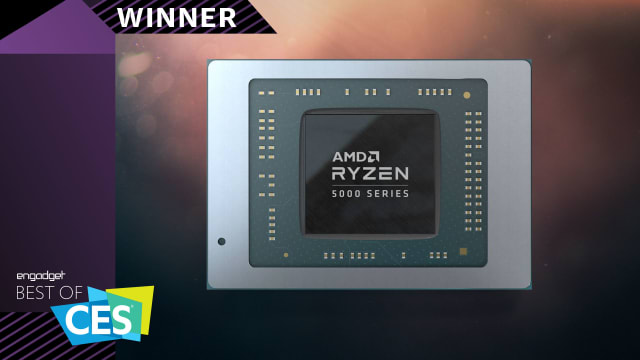
AMD / Engadget
We’ll admit: It could be difficult to pitch AMD’s new Ryzen 5000 laptop chips to someone with only a passing interest in CES. What stood out at this year’s show? It would be far easier to point to self-docking boat tech or a rollable phone or perhaps an AI emotional support gerbil. But for the Best of the Best category the Engadget team tends to look for the products that have the greatest potential to change the technology landscape over the coming year. For us, that would be AMD’s new mobile chips.
AMD’s 5000 series builds on last year’s 4000-series lineup, which found their way into over 100 notebooks and other mobile form-factor devices. The 5000 series, in addition to representing an upgrade on power and efficiency, is expected to reach over 150 systems. All this at a time when Apple is showing up the competition with its own laptop-grade chips, and Intel will have to fight that much harder to retain the market share it has left. As traditional chipmakers are forced to keep pace with Apple, it’s consumers who will eventually win. — D.W.
People’s Choice Award
Razer Blade 15
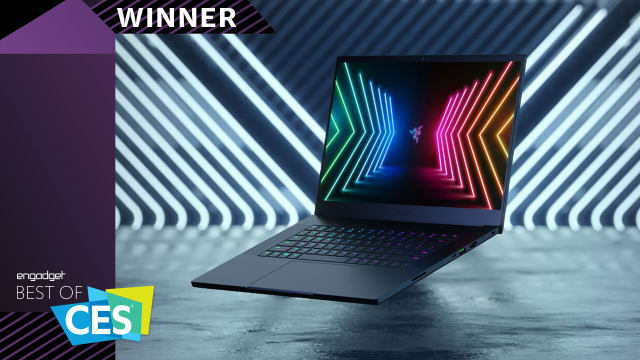
Razer/Engadget
Even though this year’s CES was all-digital, that didn’t stop Razer’s legion of fans from showing up in our People’s Choice poll. Out of roughly 17,000 votes, over 13 percent chose the Razer Blade 15 as their favorite gadget from CES 2021. This was thanks in part to the company’s robust get-out-the-vote efforts of course, but it doesn’t hurt that the Razer Blade 15 is significantly improved, with NVIDIA’s RTX 30 series graphics, and a 1440p/165Hz display option that we think will be the favorite of most gamers.



